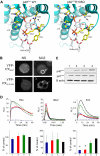A new genetic subgroup of chronic granulomatous disease with autosomal recessive mutations in p40 phox and selective defects in neutrophil NADPH oxidase activity
- PMID: 19692703
- PMCID: PMC2759653
- DOI: 10.1182/blood-2009-07-231498
A new genetic subgroup of chronic granulomatous disease with autosomal recessive mutations in p40 phox and selective defects in neutrophil NADPH oxidase activity
Abstract
Chronic granulomatous disease (CGD), an immunodeficiency with recurrent pyogenic infections and granulomatous inflammation, results from loss of phagocyte superoxide production by recessive mutations in any 1 of 4 genes encoding subunits of the phagocyte NADPH oxidase. These include gp91(phox) and p22(phox), which form the membrane-integrated flavocytochrome b, and cytosolic subunits p47(phox) and p67(phox). A fifth subunit, p40(phox), plays an important role in phagocytosis-induced superoxide production via a phox homology (PX) domain that binds to phosphatidylinositol 3-phosphate (PtdIns(3)P). We report the first case of autosomal recessive mutations in NCF4, the gene encoding p40(phox), in a boy who presented with granulomatous colitis. His neutrophils showed a substantial defect in intracellular superoxide production during phagocytosis, whereas extracellular release of superoxide elicited by phorbol ester or formyl-methionyl-leucyl-phenylalanine (fMLF) was unaffected. Genetic analysis of NCF4 showed compound heterozygosity for a frameshift mutation with premature stop codon and a missense mutation predicting a R105Q substitution in the PX domain. Parents and a sibling were healthy heterozygous carriers. p40(phox)R105Q lacked binding to PtdIns(3)P and failed to reconstitute phagocytosis-induced oxidase activity in p40(phox)-deficient granulocytes, with premature loss of p40(phox)R105Q from phagosomes. Thus, p40(phox) binding to PtdIns(3)P is essential for phagocytosis-induced oxidant production in human neutrophils and its absence can be associated with disease.
Figures

 ) were visible throughout the colon at the time of presentation. Biopsies showed prominent epithelioid granulomata in lymphoid aggregates (B,
) were visible throughout the colon at the time of presentation. Biopsies showed prominent epithelioid granulomata in lymphoid aggregates (B,  ) and in lamina propria (C) with giant cells (inset). Four-μm sections were stained using hematoxylin and eosin prior to microscopy and photomicrographs were taken with a Nikon Eclipse 80i microscope equipped with a Nikon Digital Sight DS-U1 camera using 20×/0.50NA and 40×/0.75NA objectives. (D) DHR123 fluorescence in control (black line) and patient (red line) neutrophils before and after stimulation with 0.6 μg/mL PMA (representative of 5 assays).
) and in lamina propria (C) with giant cells (inset). Four-μm sections were stained using hematoxylin and eosin prior to microscopy and photomicrographs were taken with a Nikon Eclipse 80i microscope equipped with a Nikon Digital Sight DS-U1 camera using 20×/0.50NA and 40×/0.75NA objectives. (D) DHR123 fluorescence in control (black line) and patient (red line) neutrophils before and after stimulation with 0.6 μg/mL PMA (representative of 5 assays).



References
-
- Dinauer MC, Newburger PE. The phagocyte system and disorders of granulopoiesis and granulocyte function. In: Nathan DG, Orkin SH, Ginsburg D, Look AT, D.E. F, Lux SE, editors. Nathan and Oski's Hematology of Infancy and Childhood. 7th Ed. Philadelphia, PA: WB Saunders Company; 2008. pp. 1109–1220.
-
- Matute JD, Arias AA, Dinauer MC, Patino PJ. p40phox: the last NADPH oxidase subunit. Blood Cells Mol Dis. 2005;35(2):291–302. - PubMed
-
- Holland SM. Chronic Granulomatous Disease. Clin Rev Allergy Immunol. Prepublished on June 9, 2009, as DOI 10.1007/s12016-009-8136-z. - DOI - PubMed
-
- Winkelstein JA, Marino MC, Johnston RB, Jr, et al. Chronic granulomatous disease: report on a national registry of 368 patients. Medicine (Baltimore) 2000;79(3):155–169. - PubMed
-
- van den Berg JM, van Koppen E, Ahlin A, et al. Chronic granulomatous disease: the European experience. PLoS ONE. 2009;4(4):e5234. doi: 10.1371/journal.pone.0005234. - DOI - PMC - PubMed
Publication types
MeSH terms
Substances
Grants and funding
LinkOut - more resources
Full Text Sources
Medical
Molecular Biology Databases

